MVTec
MERLIC 5-A NEW GENERATION OF MACHINE VISION SOFTWARE
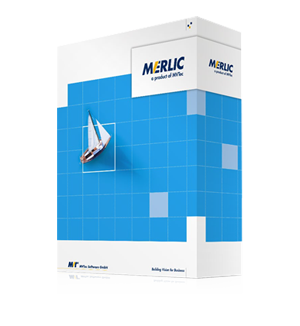
MVTec MERLIC is an all-in-one software product for quickly building machine vision applications without any need for programming.
MERLIC 5 is a logical continuation of the approach taken since MERLIC 5. It aims to solve demanding machine vision applications, while being quick and easy to implement. This new version provides customers with our latest deep learning features, even without them having deep knowledge in programming or in fact requiring them to write a single line of code.
5.5 What's changing?
For improved process integration, a new TCP socket plugin has been developed that enables text-based communication with devices that do not support complex protocols. The new technologies include the deep-learning-based method Deep Counting for counting large quantities of objects, as well as a new tool for recognizing colors. Another new feature, “High Dynamic Range (HDR) imaging”, makes it possible to process high contrast differences and effectively eliminate overexposed or underexposed areas in images.
New TCP socket plug-in
MERLIC 5.5 extends its connectivity capabilities with the introduction of a new TCP socket plug-in. This plug-in features the ability to use a highly customizable, text-based protocol. Users can now configure specific, simple ASCII messages that contain only the information relevant to their application. These messages can be easily processed by devices that do not support complex protocols such as OPC UA. The plug-in can be easily configured within MERLIC’s RTE (Runtime Environment) Setup, providing a straightforward solution for integrating MERLIC into existing systems.
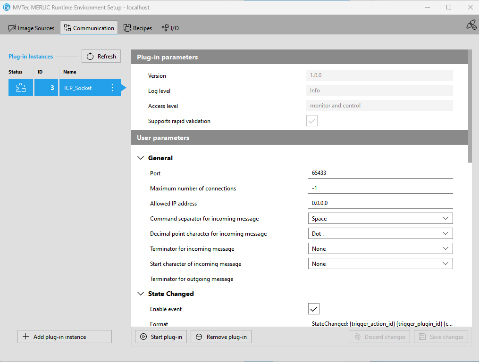
Deep Counting
The new "Count with Deep Learning" concept tool in MERLIC 5.5 allows users to count many objects efficiently and accurately while also detecting their positions. Unlike other deep-learning-based methods, this feature can be rapidly trained with minimal labeling. This streamlines the process and significantly boosts the efficiency of object counting, particularly in scenarios involving deformable materials or bulk goods. Simultaneously, this also reduces the time and cost typically associated with deep learning model training.
New color recognition tool
MERLIC 5.5 introduces a new way to handle colors. After training, the new “Recognize Color” concept tool then enables the reliable detection of colors in various conditions. Users can even further refine detection accuracy by setting specific thresholds for acceptable deviations. Ideal for a range of use cases, such as part verification or selection, verifying proper cable connections, or confirming the installation of the correct resistor, this concept tool helps streamlining and enhancing quality control processes.
High Dynamic Range (HDR) Imaging
MERLIC 5.5 includes new methods for HDR (High Dynamic Range) imaging. This feature extends the existing “Merge Images” tool, now equipped with HDR functionality to combine images of varying exposures into a single HDR image. This enhancement ensures that high contrast differences are handled, effectively eliminating overexposed or underexposed areas in images. As a result, even the most challenging lighting conditions can be accurately represented and analyzed. This opens up new possibilities for a variety of applications, including the measurement of reflective surfaces and increasing the dynamic range of an image.
>5.4 What's changing?
With the new version 5.3 it is now possible to use training functionalities in the MERLIC Frontend even during runtime. For example, new matching models or code reading parameters can be trained. This means that the end customer can also perform training for other products directly on the production line in the MERLIC Frontend. This significantly increases flexibility and application possibilities.
REST plug-in for MERLIC
MERLIC 5.4 extends the available MERLIC Communicator plug-ins with a REST plug-in. This interface opens the door to the world of web services.
MERLIC users benefit from being able to control the software through this important interface, using a frontend on the web browser. Furthermore, the results of the machine vision application can also be displayed in a device-independent manner, for example on mobile devices.
Modicon®* plug-in for MERLIC
A new plugin in MERLIC 5.4 allows users to access the Schneider Electric Modicon PLC ®. This broadens the range of applications that can be easily integrated with MERLIC. For instance, this integration would enable robots and MERLIC to collaborate directly using a Modicon PLC ® that operates on the Modbus protocol.
Modicon® is a registered trademark of Schneider Electric USA, Inc.
Acquisition Sequences
MERLIC users regularly have the opportunity to test new developments at an early stage and to contribute to further advancements. In MERLIC 5.4 this is the case with "Acquisition Sequences". This concept feature introduces new possibilities for image acquisition. For instance, when dealing with a poorly lit object, users can now acquire images with both short and long exposure times, which are then merged into a single image. As a result, challenging object characteristics are balanced, resulting in improved visibility of details.
Enhanced image handling in the MERLIC RTE SetupEnhanced image handling in the MERLIC RTE Setup In MERLIC 5.4 working with images in the MERLIC RTE Setup has been improved. It is now possible to save acquired images directly to a file. This makes generating image datasets for training deep learning models very easy, for example.
>5.3 NEWEST MERLIC FEATURE
TRAINING FUNCTIONALITIES IN THE MERLIC FRONTEND
In version 5.3, the new feature set focuses mostly on easier process integration. Thanks to newly developed plug-ins, MERLIC can now be operated via the popular REST interface as well as controlled by a Schneider Electric Modicon PLC®.
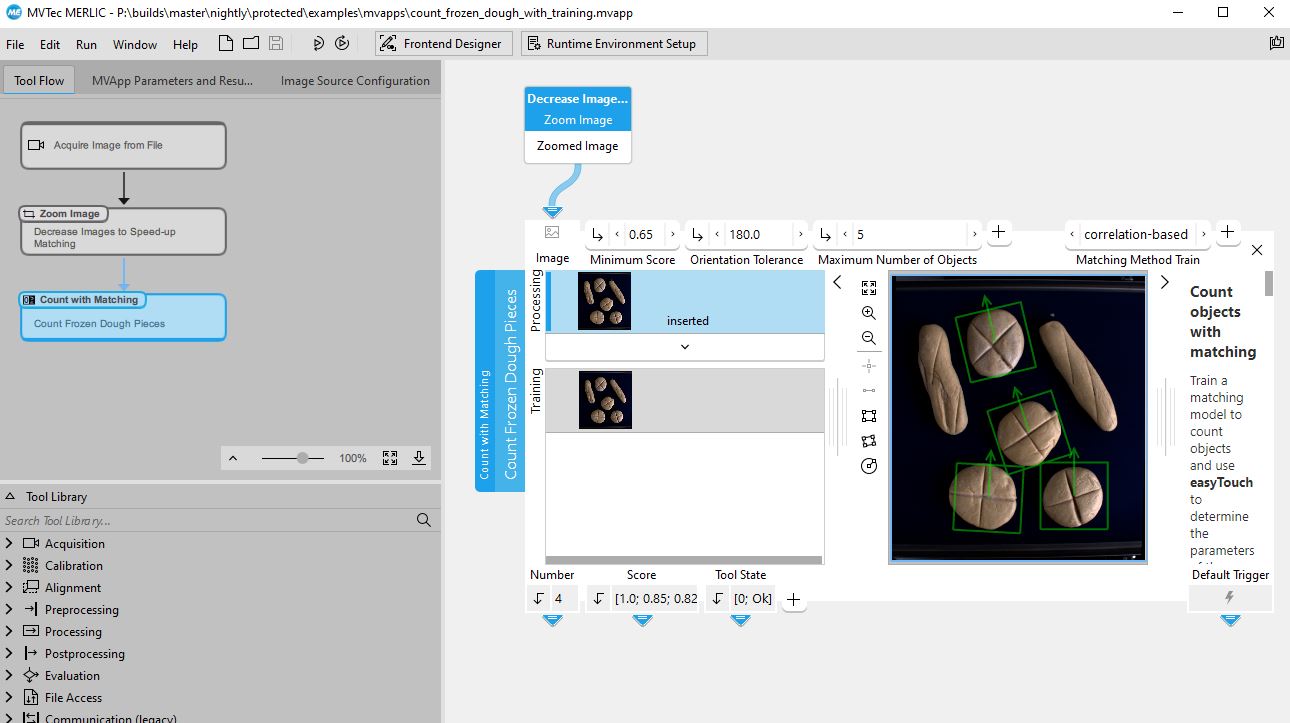
NEW TOOL FOR DEEP LEARNING-BASED OBJECT DETECTION
The deep learning technology for object detection is now also available in MERLIC. The "Find Object" tool locates trained object classes and identifies them with a surrounding rectangle (bounding box). Touching or partially overlapping objects are also separated, which allows counting of objects. Labeling and training are possible without programming knowledge using the free MVTec Deep Learning Tool. The trained network can then be loaded into MERLIC and used with a single click.
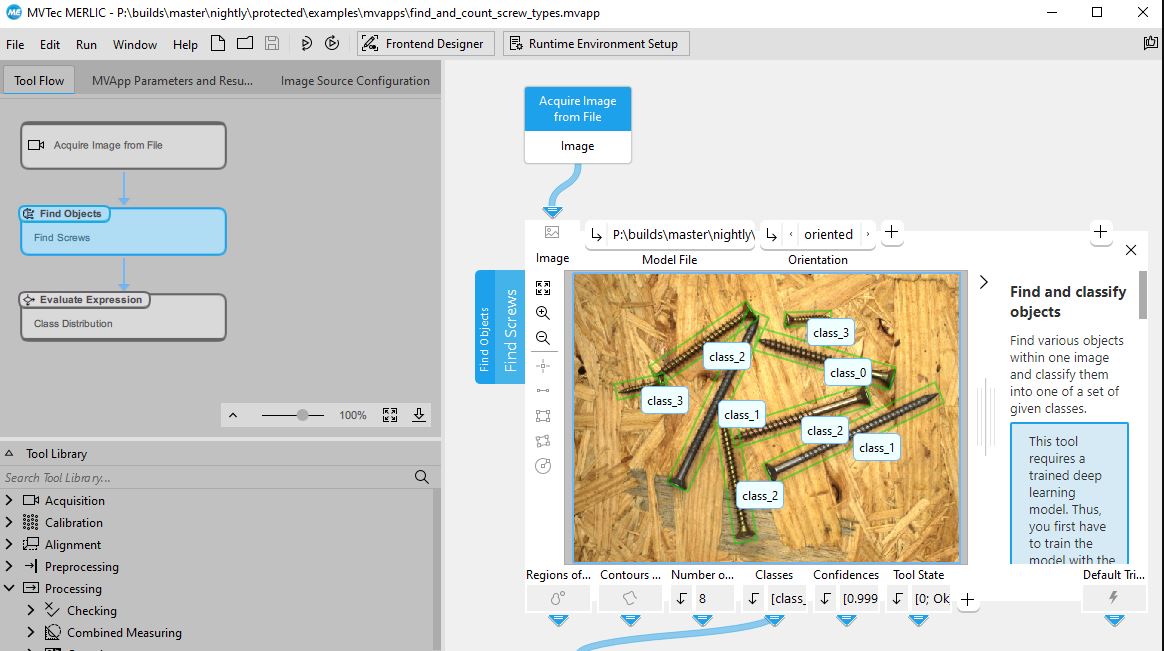
CONCISE STARTUP DIALOG FOR EASY ACCESS TO FUNCTIONS AND MACHINE VISION APPLICATIONS
Usability is one of MERLIC's unique selling points. To further strengthen this ease-of-use approach, a start dialog with thumbnails was integrated into the MERLIC Creator. This allows users to get an overview of their most recently opened MVApps. All standard examples are clearly displayed. Especially for new users, these offer an orientation to reliably create their own applications. In addition, helpful introductory material as well as the documentation can be easily accessed via quick links.
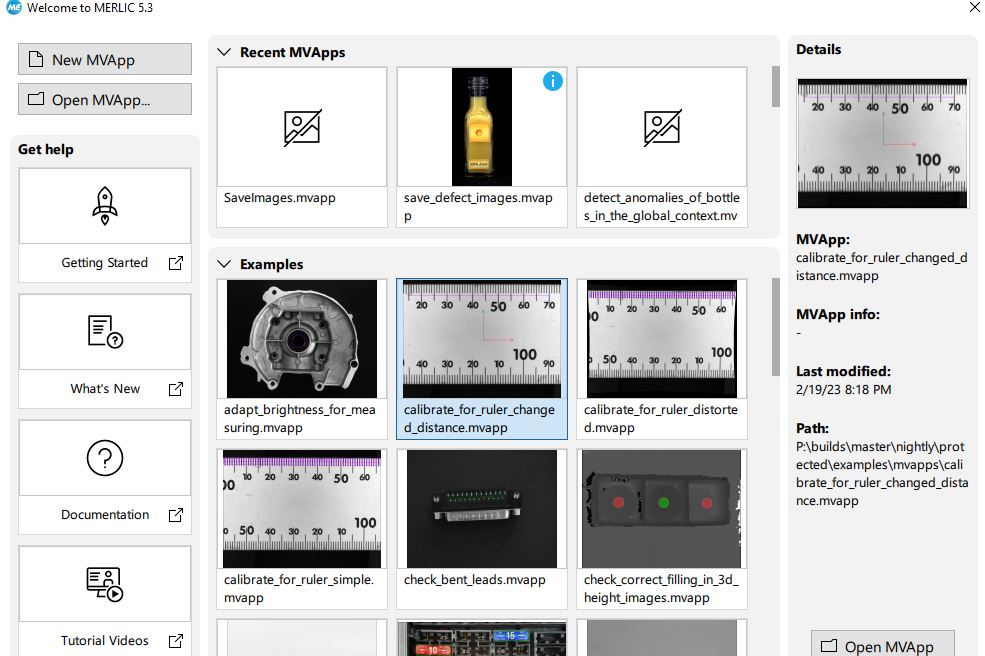
GLOBAL CONTEXT ANOMALY DETECTION
MERLIC 5.2 verfügt über die neu entwickelte Deep Learning Methode "Global Context Anomaly Detection". Diese hochmoderne Technologie erkennt neue Varianten von Anomalien, indem sie den logischen Inhalt von Bildern "versteht". Diese Funktion ist besonders nützlich in allen Branchen, die während ihres Produktionsprozesses Vollständigkeitskontrollen, Qualitätsprüfungen, Fehlererkennung oder Druckinspektionen benötigen. Alles, was dazu erforderlich ist, sind Bilder von guter Qualität, wodurch keine zeitaufwändige Beschriftung erforderlich ist.
Für das Training von Deep Learning Anwendungen kann das kostenlose Deep Learning Tool (DLT) von MVTec verwendet werden. Die Ergebnisse können dann aus dem DLT in MERLIC importiert und dort ohne Programmieraufwand ausgeführt werden.
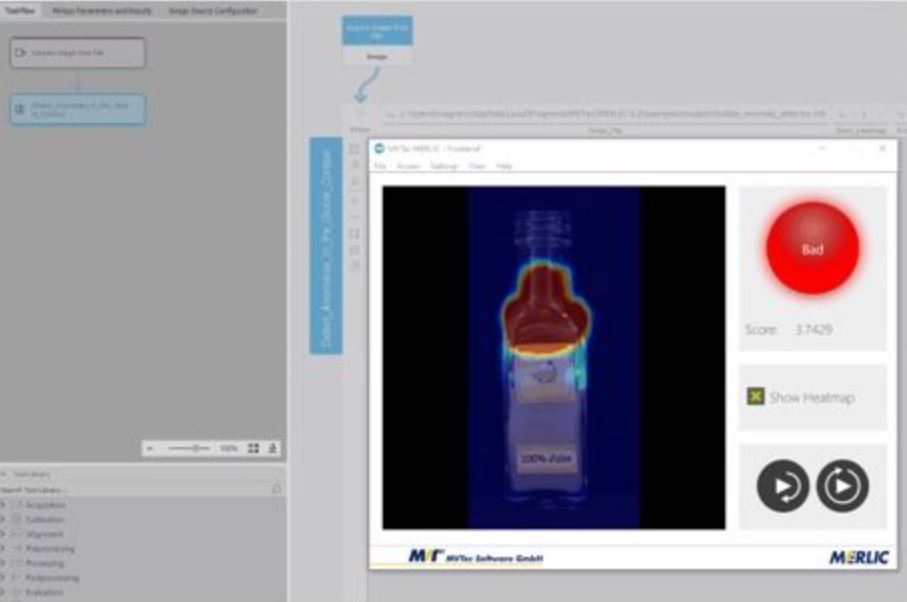
MVTEC EASYPARAMS
Mit der Einführung von MVTec EasyParams in MERLIC 5.2 ist das Finden und Einstellen der relevanten Kameraparameter so einfach wie nie zuvor. Das unkomplizierte Konfigurationswerkzeug ermöglicht es Ihnen, unabhängig vom Kamerahersteller, Ihre Anwendung schneller in Betrieb zu nehmen. MERLIC EasyParams speichert alle Ihre Einstellungen automatisch, so dass Sie die Anzahl der von MERLIC kompatiblen Kameras erhöhen können.
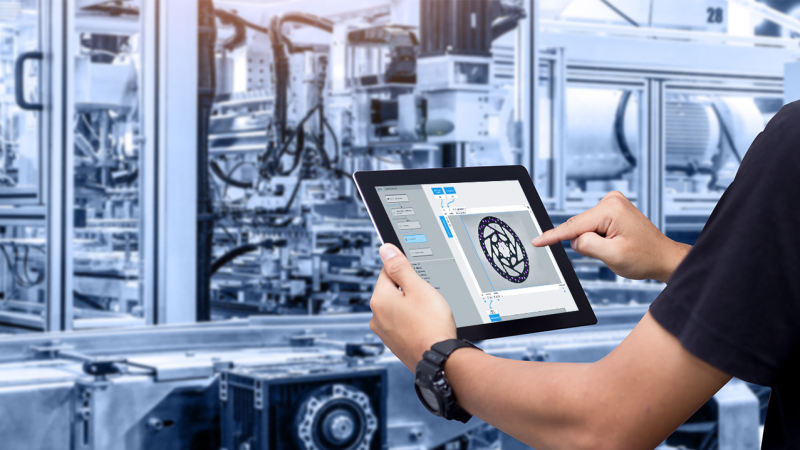
ERWEITERUNG DES FUNKTIONSUMFANGS DER "EXTENSION-TOOLS"
Mit dem neuen "Extension Tool Add-On" können Sie in MERLIC 5.2 noch anspruchsvollere Bildverarbeitungsanwendungen implementieren. Dies ermöglicht insbesondere fortgeschrittenen Anwendern, ihre eigenen Tools auf Basis von MVTec HALCON zu implementieren. Verbinden Sie die Entwicklungsumgebung HDevelop direkt mit MERLIC. Damit steht Ihnen alles zur Verfügung, was Sie brauchen, um die Ausführung eines benutzerdefinierten Tools in HDevelop zu verfolgen und das Debugging zu erleichtern.
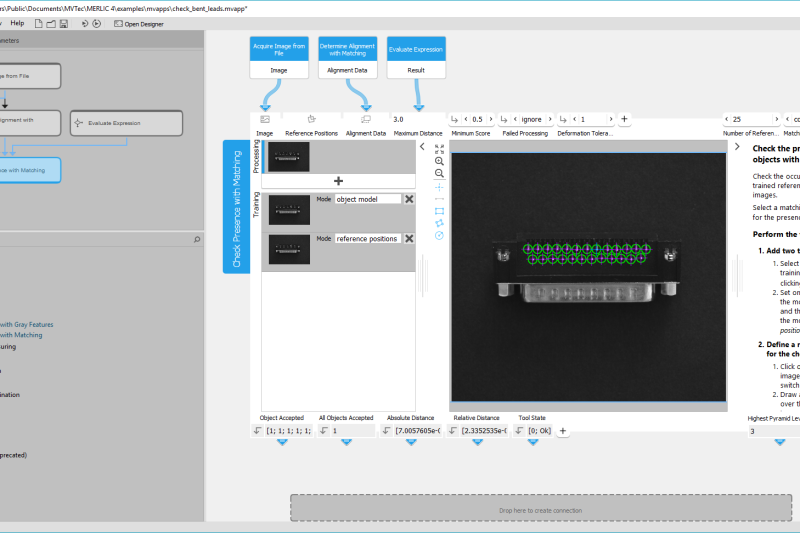
EXPORT VON BILDDATEN AUS MERLIC IN ANDERE SCHNITTSTELLEN
Mit dieser praktischen Funktion kann der Anwender Bilder für Visualisierungszwecke direkt über die Kommunikationsschnittstelle nutzen. Ein nun ebenfalls im Lieferumfang enthaltenes Kommunikations-Plugin ermöglicht es, Bilder separat zu speichern, etwa für die Qualitätssicherung.
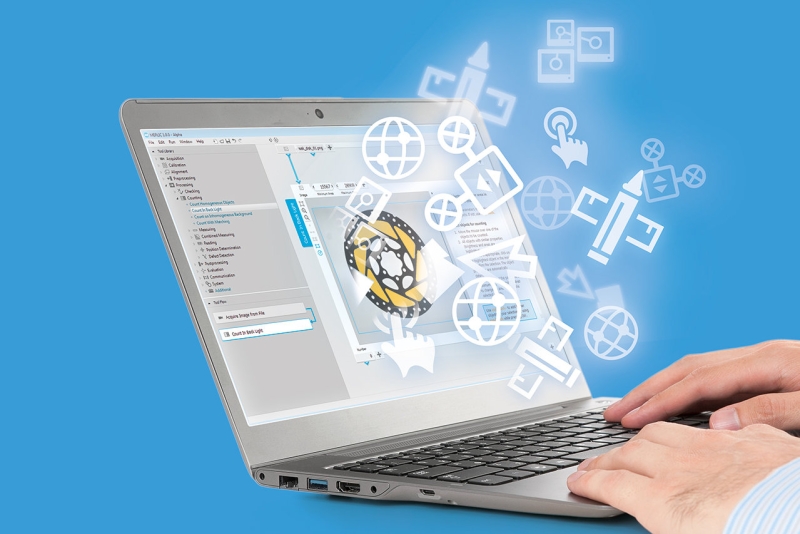
CONCEPT-TOOLS: VORGESCHMACK AUF "SEGMENT IMAGE PIXEL-PRECISE"
„Concept Tools“ in MERLIC bieten für Kunden einen ersten Vorgeschmack auf zukünftige Funktionen. Zugleich können diese mit den Tools erste Evaluierungen möglicher neuer Anwendungen durchführen. Zudem trägen das Kundenfeedback aktiv zur Entwicklung bei. In MERLIC 5.2 kann im Rahmen des Concept Tools-AI das Deep-Learning-basierte Feature "Segment Image Pixel-Precise“ getestet werden. Damit ist es möglich trainierte Fehlerklassen pixelgenau zu lokalisieren. So können Anwender z.B. Inspektionsaufgaben lösen, die bisher gar nicht oder nur mit erheblichem Programmieraufwand realisierbar waren.
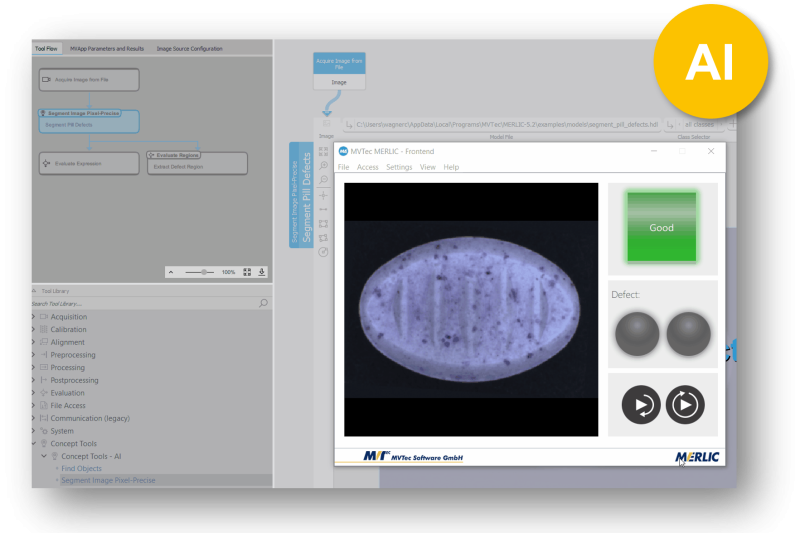
DEEP OCR
MERLIC 5.1 includes a new tool for optical character recognition, which is based on HALCON’s Deep OCR technology.
Compared to other algorithms, this holistic deep-learning-based approach can localize characters much more robustly, regardless of their orientation, font type, and polarity – and requires significantly less parameter tuning. Recognition performance is further increased by the automatic grouping of characters. This allows the identification of whole words and thus reduces the chance of misinterpretation of similar-looking characters. This new tool does not require the Deep Learning Add-On. It is included in all MERLIC packages, starting with the MERLIC S package.
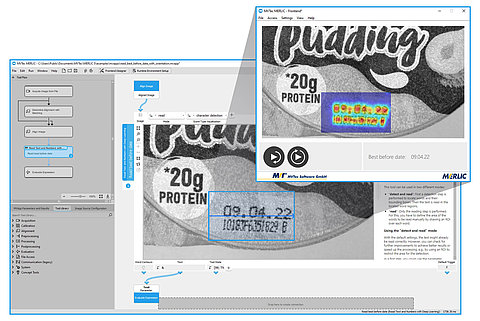
MERLIC 5.1 includes a deep-learning-based OCR tool.
SUPPORT FOR AI ACCELERATOR HARDWARE
MERLIC 5.1 includes Artificial Intelligence Acceleration Interface (AI²) plug-ins for the NVIDIA® TensorRT™ SDK and the Intel® Distribution of OpenVINO™ toolkit.
This enables users to benefit from compatible AI accelerator hardware – quickly and conveniently. MERLIC tools using deep learning functionality can thus achieve significantly faster inference times when paired with compatible hardware like NVIDIA GPUs or Intel processors including GPUs, CPUs and VPUs like the Intel® Movidius™ Neural Compute Stick. By expanding the range of supported Intel devices, customers now have even more flexibility in their choice of hardware. By adding support for AI², MERLIC will also benefit from any future plug-ins that integrate new accelerator hardware.
IMAGE SOURCE MANAGER IMPROVEMENTS
In MERLIC 5.1, selecting and setting the correct camera parameters within the Image Source Manager (ISM) is further simplified.
If a camera is to be set up, the required parameters can now be found much faster. The search for parameters can now be carried out via the ISM GUI, similarly to the search function in the Tool Library. With this search function, the right parameters can be found quickly and easily. In addition, it is now possible to filter for persistent parameters that are stored in the camera, even if the camera is switched off. Furthermore, configurations and image sources can now be renamed in MERLIC RTE Setup. Finally, the connection status of cameras that support this feature is now displayed
IMPROVED EVALUATE EXPRESSION TOOL
With MERLIC 5.1, the "Evaluate Expression" tool has been extended. Now, any number of evaluations can be performed within the same tool.
This reduces the number of required "Evaluate Expression" tools compared to MERLIC 5 and leads to a leaner Tool Flow, especially in more complex MVApps. In addition, it is now easier to link different results.
TEST VERSION: MERLIC FOR LINUX ON PC AND MERLIC FOR ARM-BASED PLATFORMS
Starting with MERLIC 5.1, a test version is available for evaluating MERLIC RTE (Runtime Environment) for Linux on PC and for Arm-based platforms.
This means that both embedded devices based on the widely used Arm architecture and Linux alternatives to the typical Windows operating system can now be tested for image processing with MERLIC. This is a first step towards making MERLIC available on additional platforms in the future.
Developing the MVApp is still done on a Windows system with the MERLIC Creator. The application can then be tested on the "new" systems using MERLIC RTE for Arm-based platforms and Linux. Cameras can be set up remotely with the help of MERLIC RTE Setup.
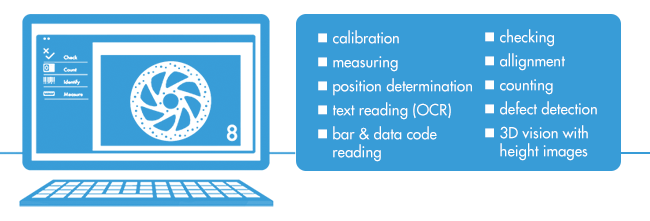
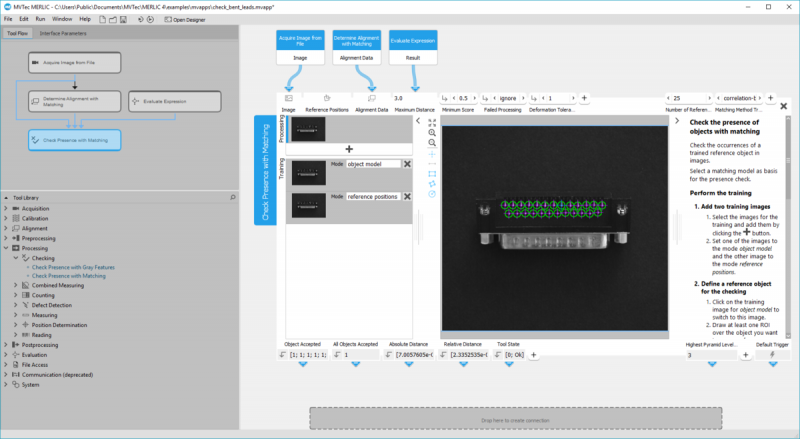

IMAGE-CENTERED USER INTERFACE WITHOUT PROGRAMMING
The image-centered design allows you to configure the application directly via the image without the need to write source code or to adjust lots of parameters.
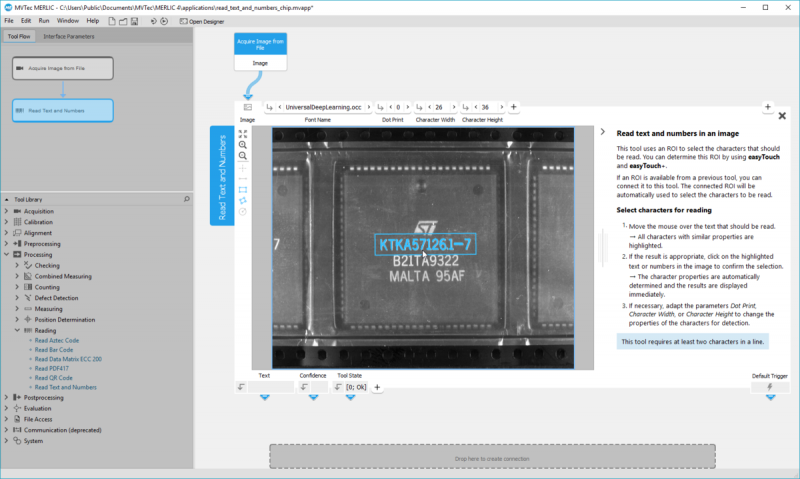

EasyTouch
An outstanding, innovative, and unique feature in MERLIC is the easyTouch concept. It guides you towards your solution interactively.
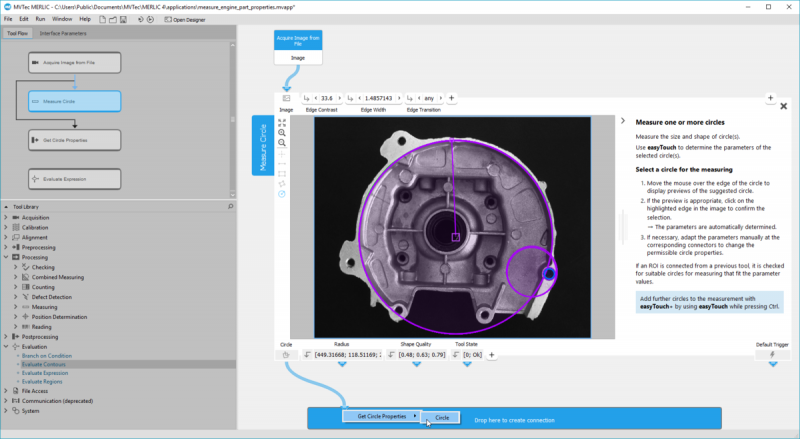

MACHINE VISION APPLICATION WITHOUT PROGRAMMING
While most common machine vision programs require extensive programming knowledge, MERLIC was created to build a machine vision application without programming a single line of code. So instead of coding line by line, you can simply step through your application and rely on the many standard machine vision tools. The vision tools in the MERLIC "MVApp" are connected automatically. Alternatively, you can simply reconnect them by drag & drop.
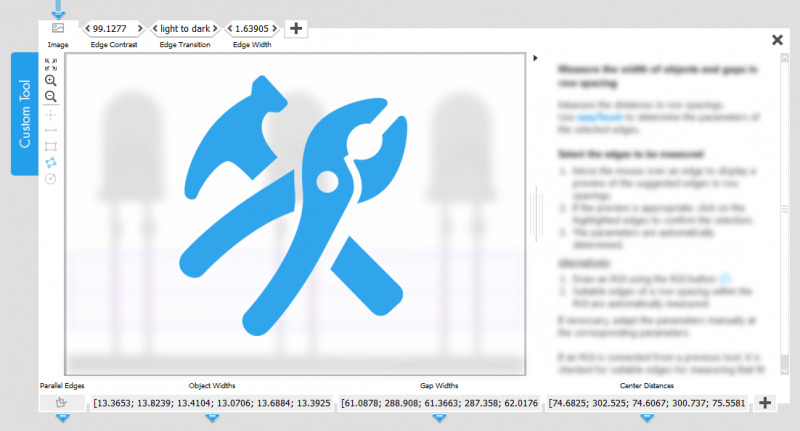

CUSTOM TOOLS
MERLIC's existing tool library can be extended flexibly with customized, user-defined tools to suit any additional needs. These "custom tools" can be developed in MVTec HALCON's integrated development environment HDevelop. Customers who want to create a new custom tool or make an existing tool available in MERLIC 4 can contact MVTec support.

EXTENSION TOOLS
MERLIC's existing tool library can be extended flexibly with customized, user-defined tools to suit any additional needs. These "extension tools" can be developed in MVTec HALCON's integrated development environment HDevelop. Customers who want to create a new extension tool for MERLIC need a HALCON development license (preferred "HALCON Progress" for availability of the newest features) for developing and the MERLIC add-on "Extension Tools" for executing it.

PARALLEL PROCESSING
MERLIC supports the parallel processing and execution of different tools. This makes it possible to solve different image processing tasks in one instance and greatly simplifies the implementation of multi-camera setups.
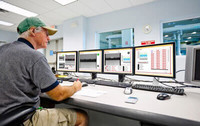

MULTIPLE FRONTENDS
MERLIC allows you to run the frontend and the processing of your application on separate computers. You can also open various frontends from different computers to check the machine.
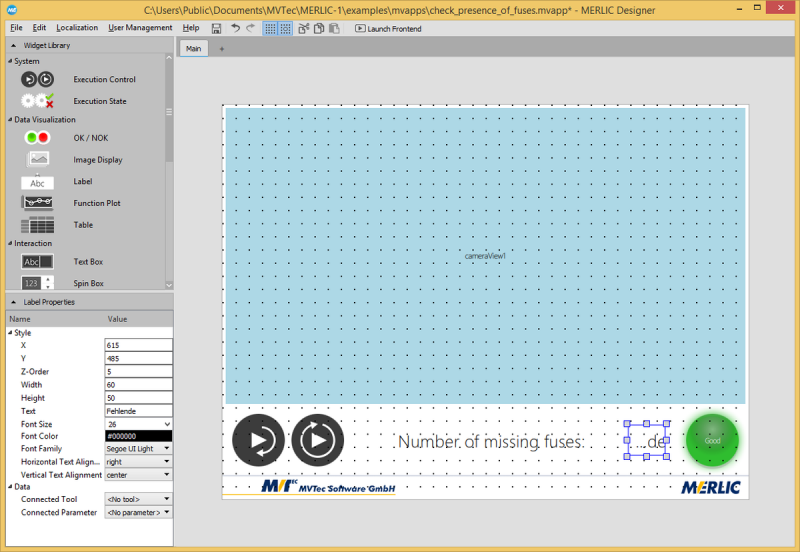

MERLIC DESIGNER
Interactively design a frontend for your application: choose between various widgets and simply place them by drag-and-drop.
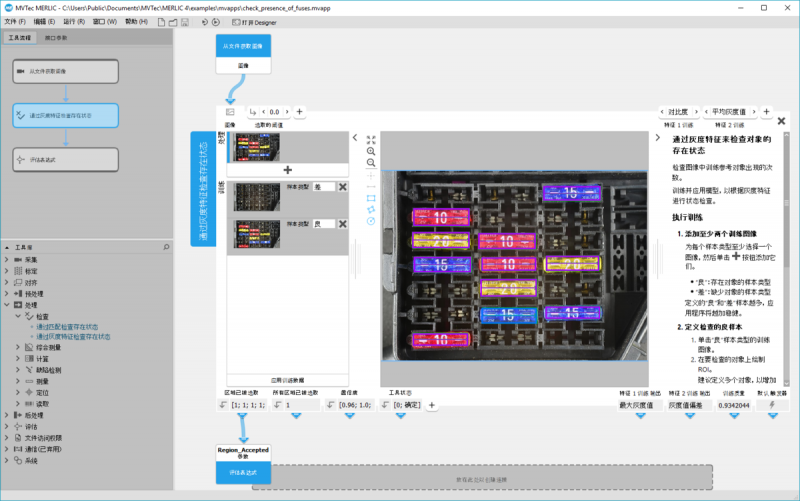

MULTIPLE LANGUAGES
The graphical user interface (GUI) as well as the entire standard documentation is available for you in simplified and traditional Chinese, English, French, German, Italian, Japanese, Spanish, and Thai.
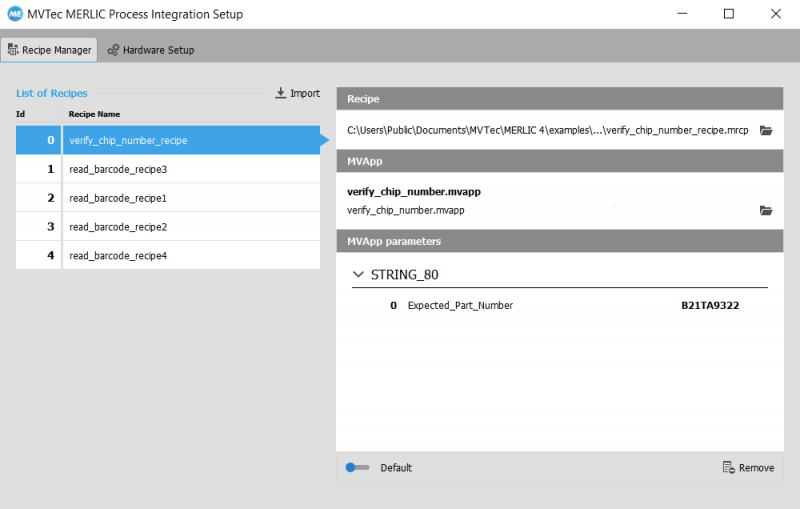

INTEGRATED PLC COMMUNICATION
MERLIC offers full integration for your entire application, including the programmable control (PLC). MERLIC 4 can communicate with common industrial protocols like EtherCAT and PROFINET via Hilscher PC cards.
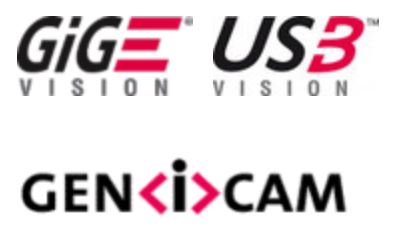

IMAGE ACQUISITION INTERFACES
MERLIC supports all USB3 Vision and GigE Vision compliant cameras as well as image acquisition hardware supporting the GenICam GenTL standard. Digital interfaces of cameras are supported through GenICam digital I/O control. Currently, MERLIC does not support Hardware-trigger for cameras and GPIO connectors for digital interfaces.
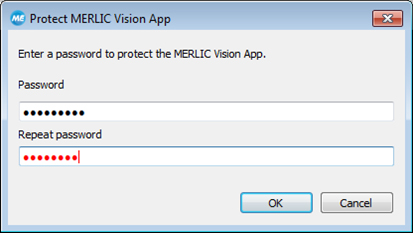

APPS PROTECTION
MERLIC secures your know-how: you can protect the content of MERLIC applications (MVApps) with a password. The password protection can be enabled for each MVApp in the MERLIC Backend (note: it is not enabled by default). Thus, when loading the MVApp in the MERLIC Backend the password must be entered in order to change the MVApp. Using the password protection can be useful if you want to pass on a MERLIC MVApp to customers who should not be able to change the application. Furthermore, this is important to protect your MVApps against non-authorised access from third parties to secure your intellectual property of the application.

3D VISION WITH HEIGHT IMAGES
MERLIC also offers 3D vision tools based on height images which, for example, enable users to read embossed text and perform other 3D machine vision tasks. For this, tools are included that make it possible to prepare images from 3D sensors or 3D cameras so that inspections can be subsequently carried out using MERLIC’s existing 2D tools. These tools enable the conversion of a disparity image into a 3D height image, the alignment of a selected plane, the compensation of outliers and invalid pixels in the image data, as well as the scaling of height image values into an 8-bit image. Please find some configration tips for 3D sensors in the chapter "Acquisition" of the MERLIC general manual that comes with your MERLIC installation. You can also find additional information here on our website.
